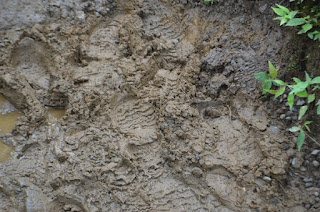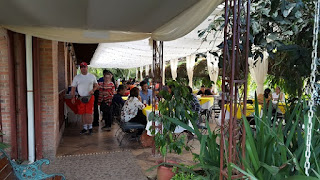and make sure he naps, that much driving is not possible in a single day. Once it had become clear that we would be heading back to spend some time at their home in an oceanfront community, I began searching for accommodations at some interesting location in between. With only about a week’s notice, it was not easy finding a place which, at the height of high season, still had two rooms and would allow a dog. I looked in vain at the vicinity of the Poas Volcano and Bajos del Toro, at La Fortuna and the area around Volcán Arenal. Finally I settled on a couple of simple lodging places in the vicinity of the Rio Celeste, a lovely river noted for its sky-blue color (celeste) and the national park containing Volcán Tenório. We settled on Posada Rio Celeste la Amistad, which according to Waze and Google Maps should be a 4-1/2 hour drive.
But, before we could leave, Sam and Nafisa had to register Soraya’s birth with the Costa Rican government, the first step toward getting her birth certificate and, eventually, her US passport. It was 11 AM before we finally made it into to the Registro Civil, and it took an hour to get the paperwork done. They got there just in time - as they were finishing up, ten other people were in line to get paperwork done. Note the numbers on the back of the chairs. As people went to the desks, the folks online would change chairs until reaching chair number 1, the next in line to be seen.
It was Sam and Nafisa’s final meeting with their midwife, Rebecca, who came by to make sure everything was going smoothly as well as to pick up the keys to the house.

It was noon before we hit the road, and the timing for our arrival at our Posada was getting dicey. Before we left, I had scoped out possible places to eat lunch in a variety of towns roughly two to three hours from Turrialba. We stopped at none of them — Sam was leading our caravan of two cars, and they stopped at Polla Oli in Guapiles, the same place where they had stopped on the way to Turrialba. They apparently had a good experience there in early December, but I found it disappointing. We ordered a couple of roasted whole chicken, and they were overcooked and dry. They came with patacones (fried thin-sliced green plantains). a two-liter bottle of soda (no substitutions for juice allowed) an two accompaniments – the small bowls of pickled vegetables were OK. A must miss.
From there, we kept driving toward our posada – dusk came, then dark. As we left the main road and started climbing a bit, it was raining, and the fog set in, and the roads got rough. Finally, our posada was in sight, and we pulled in. It was 6:30. We got our room keys and headed for the small outdoor dining area where we had our simple dinners: they offer only casados, a choice of chicken fillet, beef or pork, or fried fish, served on a plate with a salad and a few sliced of fried plaintains and a slice of queso, as well as rice and beans as well as cold pickled vegetables and a warm succotash of potato and corn. For dessert there was some sort of puree of pineapple with coconut. A couple of families were finishing up as we sat down but for the most part we had the restaurant to ourselves.
The rooms are in small buildings called cabins, set on a simple ground with hills surrounding.
They rooms are very basic, maybe 9 feet by 12 feet, largely consumed by a bed with a mosquito net, no desk, a few hangers for clothing, a couple of shelves built into a corner of the room with electrical outlets above
The walls are quite thin so that you can hear what is being said, even in conversational tone, in the room next door. The corrugated metal of the roof was visible as the ceiling of our room, and when it rained hard for much of our first night, we could really hear the noise of the rain hitting the roof. When I took my showers I could not get any hot water; Nancy reported that for her afternoon shower after our hike she got warm water. Very simple, rustic accommodations. And although they advertise on booking.com as being willing to take credit cards, the confirmation of reservation indicated that they "prefer" cash, and this preference is enforced by adding a 13% surcharge for payment by credit card,
Waking up the next morning, there are a couple of parrots who hang out in trees near the restaurant in the morning
The following day we spotted this bird in a tree on the premises
but we soon learned why the boots were recommended – many parts of the trail consisted of mud a few inches deep.
Hikers in tennis shoes kept looking gingerly for ways to walk without getting their feet immersed in the mud – impossible!
Not long into the walk, we spotted some monkeys in the trees overhead
Some parts of the trail were muddy, and some were a bit steep – and when it was both steep and muddy it was especially challenging. Still, it took us less than an hour to walk the 1.9 kilometers (one of the other hikers showed me her pedometer) to the first major attraction, a waterfall.
There was a sturdy concrete staircase, with firm wooden handrails,
all the way down to the base of the falls
As in the Rio Celeste itself, the water is so blue because of sulfur from the volcano and calcium carbonate
Sam and Nafisa headed back at point – Nafisa was still less than two weeks postpartum, while Nancy and Paul forged ahead. There was a viewpoint, a raised platform, another half a kilometer along, but it was too cloudy to get a good view of the volcano.
The next sight was the lagoon, a deep blue
It would have been another half kilometer to the “Teniderios,” the place where the Rio Celeste merges into a regular brown river, but Nancy’s feet were hurting from the boots, and reportedly it was going to be even muddier on the way there.
On the way back, a lovely butterfly flashed by and alit on the ground near the path. It had bright red on its wings, but sitting on the ground only the brown underside of the wings could be seen, allowing it to blend in with its surroundings
Just before hitting the concrete part of the pathway, we crossed this stream. On the way in I had just seen it as an inconvenience to be forded, an early indication that we had chosen wisely by renting boots. But on the way back, it was a great way to washing most of the mud off our boots, so that they would not soil our car while driving back to the hotel
As we left the park, there were two possible lunch places across the road from each other, We chose to eat at the Soda el Parque, which appeared to be the more substantial of the two. I had a delicious arroz con pollo.
The following day, on the way to Guanacaste, we paused at a location near Cabinas Piuri (the only other place that had two rooms and this entered my consideration for that stay) where the road crossed the Rio Celeste, where we were able to appreciate just how blue the river is,
It was a lovely setting: maybe it would have been interesting to stay there!
Sam had chatted with this family before they headed down to the water for their bracing swim.
It was a four-hour drive to Playa Flamingo, where Sam and Nafisa live, after Waze sent us the wrong way at first. After passing the Libéria airport, we stopped for lunch at Café Europa. Their list of German beers was pretty good in the Costa Rican context, where the Budweiser-like Pilsen and Imperial rule almost every roost; the food was pedestrian. But the outdoor garden-like seating was very nice and there was an excellent play-area for Abe.
Finally, we reached Playa Flamingo. The mountains had been chilly at night, and only temperate during the daytime. But now, it was like California! We enjoyed this lovely view from the walled area outside their apartment overlooking the town.






















































